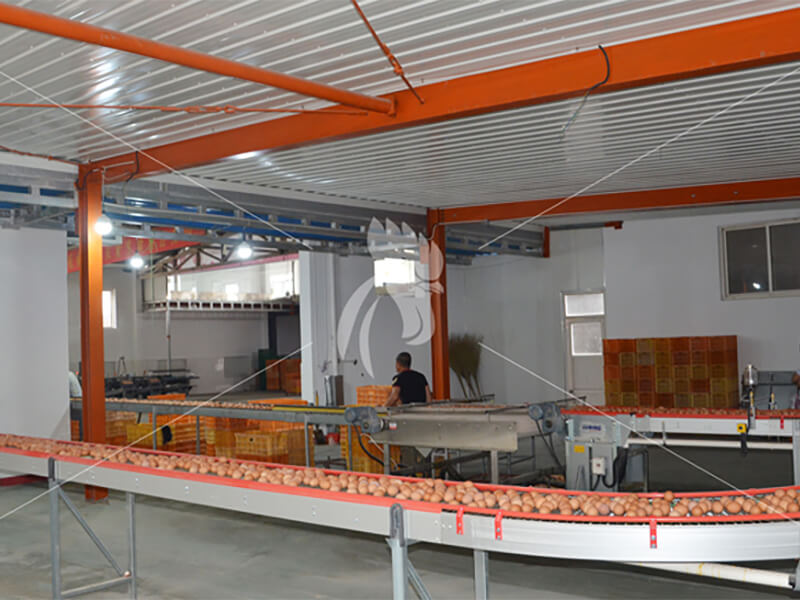In production, the chicken farm should always pay attention to the egg damage of the flock and assess whether the damage is at a normal level. The lower the egg breakage rate, the better. A comprehensive analysis of the reasons that affect the egg breakage rate mainly includes the following aspects:
1.Reasons for the breed of chickens
Egg shell quality has high heritability, and there are certain differences between different varieties or strains. Generally, brown shell eggs are significantly better than white shell eggs in terms of shell thickness and hardness. Therefore, before feeding, you should consider your own chicken farm feeding equipment to choose a suitable laying hen variety, such as choosing a well-known high-yielding laying hen variety.
- Nutritional factors of feed
The lack of nutrients for the manufacture of synthetic eggshells in the feed will inevitably lead to a decline in the quality of eggshells. Several main nutrients include calcium, phosphorus, manganese and vitamin D. The appropriate levels of addition are:
- Ensuring that the calcium content in the diet is lower than 2% or higher than 4% will reduce the quality of eggshells.
- Phosphorus. It is also an important element for eggshell synthesis. Usually, 0.5-0.6% of total phosphorus in the diet of laying hens is more appropriate. Giving higher levels of phosphorus in the early stage of laying can prevent the occurrence of fatigue in caged laying hens; however, the phosphorus content in the diet decreases with the age of the chickens, which is more conducive to the formation of high-quality eggshells, 53 weeks Reducing the phosphorus content in the future can improve eggshell quality. (Need to form a certain proportion with the content of Ca)
- Vitamin D3. Vitamin D3 can regulate the body’s absorption and metabolism of calcium and phosphorus, and providing enough vitamin D3 can increase the thickness of the eggshell. Under normal conditions, the ration should contain 2000-2500 international units of vitamin D3 per kilogram.
- Manganese. The requirement is relatively low. The requirement of manganese for laying hens is 25 mg per kilogram of the diet. When it is lower than 20 mg, the eggshell quality is reduced.
3.The impact of chicken farm feeding and management
- Stocking density. The number of chickens in the cage directly affects the damage of eggs. The crowding of chickens in the cage not only affects the food intake and nutrient intake, but also increases the frequency of trampling of chickens, causing eggs to be trampled by chickens after they are produced. Therefore, it is necessary to ensure that chickens are trampled. Only meet the standard of the breeding cage area of the breed.
- Lighting. Reasonable light is the basis for chickens to produce qualified eggs. Generally, the light intensity of laying hens is 10-20 lux, and the light time is maintained at about 16 hours. For chickens with lower body weight, it is appropriate to add 0.5 hours of nighttime light, which can make the chickens with insufficient feeding supplement part of the nutrition, which is conducive to the formation of eggshells, improves the quality of eggshells, and reduces broken eggs and shellless eggs.
- Stress. Stress can cause a sudden increase in egg breakage rate, especially in summer heat stress, which not only reduces chicken feed intake, increases thin-shell eggs, but also reduces egg production. Therefore, it is necessary to avoid or reduce the occurrence of various stresses during the peak period of daily egg laying of chickens, and keep the chicken house quiet and free from disturbance; the immunization of chickens should be carried out during the laying time; in summer, vitamin C should be added to drinking water. , reduce the degree of heat stress.
- Operation. Egg collection, packaging, transportation, loading and unloading and other operation links will also cause damage to eggs. For example, when picking eggs every day, the movements are gentle and the number of times is not less than 2 times, especially for automatic egg collection equipment. Be careful in each operation process Operation can reduce the number of broken eggs.
- Device management. Pay attention to the operation of the breeding equipment, especially the chicken cages and egg nets, every day during feeding, disinfection and inspection of the flock to ensure that they are intact and repaired in time if they are damaged or deformed; in addition, maintain the slope of the bottom of the cage so that the eggs roll out slowly after birth , to avoid bumps.
4.Disease factors
Viral diseases such as chicken infectious bronchitis and Newcastle disease will seriously cause the quality of eggshells to decline. On the one hand, the diseases cause the chickens to reduce feed intake and insufficient nutrient intake. On the other hand, these diseases directly damage the reproductive system and destroy the formation of eggshells. glands that affect eggshell formation. Therefore, it is necessary to formulate scientific。In addition, non-viral diseases also affect eggshell formation and should also be paid more attention. For example, Escherichia coli and Salmonella cause digestive tract damage, decreased digestion and absorption capacity, and decreased eggshell quality; mycotoxins in feed can also cause reproductive dysfunction, resulting in an increase in soft-shell eggs, which will increase the breakage rate. Therefore, it is necessary to ensure the cleanliness of the chicken farm breeding environment, to avoid the mixing of toxic and harmful substances into the feed or drinking water, and to prevent diseases from entering the mouth.
To sum up, there are various factors that cause the increase of egg breakage rate. In actual production, specific problems must be analyzed in detail, and symptomatic solutions can be achieved in order to ensure egg safety and improve breeding income.



